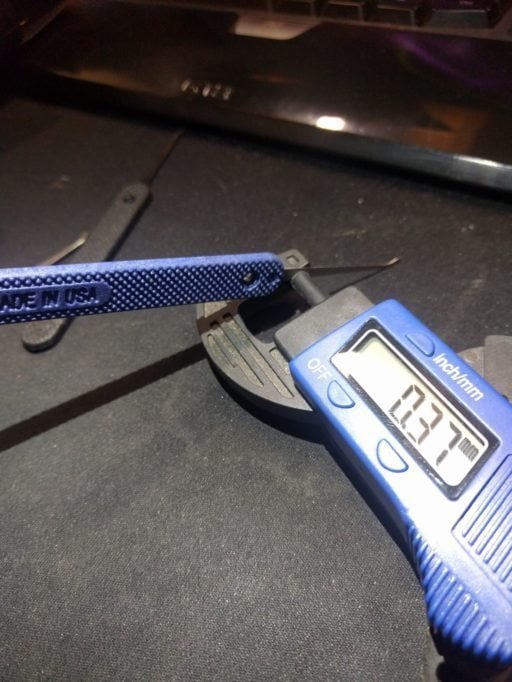One of the questions we encounter most is when to use slim picks over standard lock picks. It’s a good question! Choosing lock picks can feel overwhelming so our little guide below will help you answer this question and understand the difference between a standard lock pick and the thinner euro style picks.
When to use slim picks or standard picks
Most reputable lock pick manufacturers make picks in two varieties, slim line (“Euro-style”) lock picks and standard style lock picks.
There are only two possible variations; the length of the pick is rarely changed as its usefulness is reduced if it is shortened and there is little benefit in increasing the length noticeably.
Only the width and height are ever changed when referring to slim line picks.
Slimline “Euro Style” Lock Picks
Most commonly slim-line or Euro-style picks refer to the height of the pick along the length of it being reduced as shown in the below diagram:
As the height of the pick has been significantly reduced, it is now possible to use the same pick profile in more restricted keyways that may otherwise have difficulty moving in.
A tighter, snug fit between the lockpick and the lock, increases the chance that the height of the neck of the pick will interfere with other pins that have already been set or have not yet been picked while the tool is in use. This can cause great frustration. A slim line pick, therefore eliminates this problem. T
The width is also variable as mentioned above, this has the added benefit of greater flexibility and the ability to move in locks that would otherwise be restricted by extremely thin keyways.
As shown in the pictures of Peterson picks below, the thickness can vary greatly between picks (0.37mm vs 0.64mm). Shown below are the Peterson Slenders at 0.015 of an inch vs the standard 0.025 of an inch.


Why not use slimline lock picks all the time?
The downside of reducing thickness of the lock pick, however is that the pick is more prone to being broken or damaged during picking. This is an especially common problem for people who are new to lock picking and have not yet mastered a ‘lighter touch’. It also prevents the pick from attacking particularly stuck pins such as deep spools or a pin stuck due to corrosion/wear and tear.
Lean and (still) Mean
To combat the loss of strength when reducing the thickness of lock picks, Peterson Lock Picks, recently produced a set of lower profile, euro style lock picks with a slightly thicker profile than most euro profile. These picks were developed alongside lock picking group Toool, to produce a euro pick which could take a beating in competition, so these are great for lock sport enthusiasts.
These picks are set to a 0.018 profile, still on the narrow side provides superior strength, a real hit among the PickPals team.
Peterson Euro Slenders – Check them out here.
So which lock picks should you get?
My recommendation, if you’re a beginner, you’re probably going to want to get a ‘Standard’ pick set, it will still work in most locks you find and will last longer while you hone your picking skills and learn to use a lighter touch. We have a lot of customers who purchase our Nine piece slim set when starting out and have absolutely no issues. These picks are very strong but if you are heavy handed, do consider a standard pick set.
If you find you encounter a lot of locks with very narrow key-ways or you’ve been picking for a while and want to take the next step up then the slim-line picks are going to be the way to go. Whilst slimline lock picks are still very strong and don’t break easily, it is possible and they do suffer more when learning to pick locks.
In summary when does each property matter?
| PROFILE | PROS | CONS |
|---|---|---|
| Reduced Width | Can move in more complex locks more easily |
Can be bent out of shape or break more easily |
| Increase Width | More strength to attack harder pins, more durable, longer expected life |
Harder to move in complex locks |
| Reduced Height | Fits in more locks | Weak points are more prone to failure |
| Increased Height | More strength to attack harder pins, more durable, longer expected life |
Will not fit in all key-ways, especially paracentric ones |
| Reduced Length | N/A | Will not be able to reach pins towards the backs of locks |
| Increased Length | Can be useful in some extremely recessed keyways |
Is more likely to bend/break |
So which lock picks should you get?
My recommendation, if you’re a beginner, you’re probably going to want to get a ‘Standard’ pick set, it will still work in most locks you find and will last longer while you hone your picking skills and learn to use a lighter touch. We have a lot of customers who purchase our Nine piece slim set when starting out and have absolutely no issues. These picks are very strong but if you are heavy handed, do consider a standard pick set.
If you find you encounter a lot of locks with very narrow key-ways or you’ve been picking for a while and want to take the next step up then the slim-line picks are going to be the way to go. Whilst slimline lock picks are still very strong and don’t break easily, it is possible and they do suffer more when learning to pick locks.
PickPals has a range of slimline picks and Euro practice locks.


